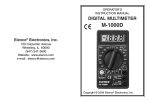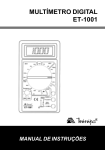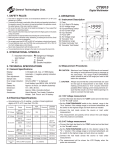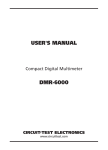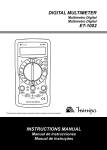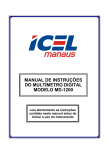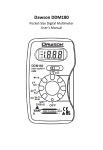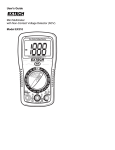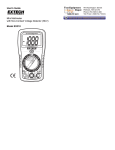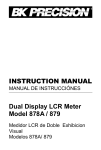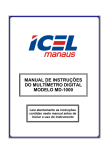Transcript
CP7672 GENERAL PURPOSE DIGITAL MULTITESTER INSTRUCTION MANUAL SAFETY GUIDELINES Your Digital Multitester is designed for both home and automotive use. The following Safety Guidelines are provided when it is used for engine or vehicle testing. To prevent accidents that could result in serious injury and/or damage to your vehicle or test equipment, carefully follow these safety rules and test procedures. SAFETY EQUIPMENT Fire Extinguisher Never work on your car without having a suitable fire extinguisher handy. A 5-lb or larger CO2 or dry chemical unit specified for gasoline/chemical/electrical fires is recommended. Fireproof Container Rags and flammable liquids should be stored only in fireproof, closed metal containers. A gasolinesoaked rag should be allowed to dry thoroughly outdoors before being discarded. Safety Goggles We recommend wearing safety goggles when working on your car, to protect your eyes from battery acid, gasoline, and dust and dirt flying off moving engine parts. NOTE: Never look directly into the carburetor throat while the engine is cranking or running, as sudden backfire can cause burns. LOOSE CLOTHING AND LONG HAIR (MOVING PARTS) Be very careful not to get your hands, hair or clothes near any moving parts such as fan blades, belts and pulleys or throttle and transmission linkages. Never wear neckties or loose clothing when working on your car. JEWELRY Never wear wrist watches, rings or other jewelry when working on your car. Youll avoid the possibility of catching them on moving parts or causing an electrical short circuit which could shock or burn you. VENTILATION The carbon monoxide in exhaust gas is highly toxic. To avoid asphyxiation, always operate vehicle in a well-ventilated area. If vehicle is in an enclosed area, exhaust should be routed directly to the outside via leakproof exhaust hose. SETTING THE BRAKE Make sure that your car is in Park or Neutral, and that the parking brake is firmly set. NOTE: Some vehicles have an automatic release on the parking brake when the gear shift lever is removed from the PARK position. This feature must be disabled when it is necessary (for testing) to have the parking brake engaged when in the DRIVE position. Refer to your vehicle service manual for more information. HOT SURFACES Avoid contact with hot surfaces such as exhaust manifolds and pipes, mufflers (catalytic converters), radiator and hoses. Never remove the radiator cap while the engine is hot, as escaping coolant under pressure may seriously burn you. SMOKING AND OPEN FLAMES Never smoke while working on your car. Gasoline vapor is highly flammable, and the gas formed in a charging battery is explosive. BATTERY Do not lay tools or equipment on the battery. Accidentally grounding the HOT battery terminal can shock or burn you and damage wiring, the battery or your tools and testers. Be careful of contact with battery acid. It can burn holes in your clothing and burn your skin or eyes. When operating any test instrument from an auxiliary battery, connect a jumper wire between the negative terminal of the auxiliary battery and ground on the vehicle under test. When working in a garage or other enclosed area, auxiliary battery should be located at least 18 inches above the floor to minimize the possibility of igniting gasoline vapors HIGH VOLTAGE High voltage 30,000 to 50,000 volts is present in the ignition coil, distributor cap, ignition wires and spark plugs. When handling ignition wires while the engine is running, use insulated pliers to avoid a shock. While not lethal, a shock may cause you to jerk involuntarily and hurt yourself. JACK The jack supplied with the vehicle should be used only for changing wheels. Never crawl under car or run engine while vehicle is on a jack. Resistance DESCRIPTION AND SPECIFICATIONS: DESCRIPTION: This Digital Multitester is a compact, hand-held, easy to use instrument compatible both with home electrical applications, as well as the electrical systems used in modern passenger cars and trucks. It may also be used to measure voltages in the computer control circuits of computer-controlled vehicles. SPECIFICATIONS: Display 3 1/2 digit, .5 inch LCD (Liquid Crystal Display) Automatic Polarity Sensing Display shows a minus (-) sign on the DC Volts and Amps functions when lead hookup is reversed. Zero adjustment Unit automatically zeroes on the volts and Amps functions. Over range indication Left side of display shows either 1 or -1 when range in a function is exceeded. Operating temperature 0°C - 35°C (32°F - 95°F), 0-80% R.H.; 35°C - 50°C (95°F - 122°F), 0-70% R.H. Range Resolution 200Ω 0.1Ω 2000Ω 1Ω 20KΩ 10Ω 200KΩ 100Ω 2000KΩ 1KΩ Max. Open Circuit Voltage Accuracy ± (0.8% rdg + 2 dgts) 2.8V ± (1% rdg + 2 dgts) h. A good diode will show a low reading with the test leads connected one way, and infinity (1) with the test leads connected the other way. The low reading will typically be some three-digit number on the display. The actual number is not critical. Transistor Check (hFE) 1. Be sure that a fresh nine (9) volt battery is correctly installed in the multitester. 2. Compare the position of the selector switch with the anticipated test result. In the case of voltage or current measurement, always select a range which is high enough to handle the worst case result! Voltage or current may be higher than you expect. 3. The BLACK test lead is always inserted in the COM (common) jack on the multitester. The RED test lead must be inserted in either the V mA (Volt-ohm-milliAmp) jack or the 10ADC (Amperes DC) jack, depending on the test being performed. Incorrect placement of the RED test lead may damage the multitester, the circuit under test, or both! W 4. The 10 Amp range on the multitester is not fused. Exercise extreme caution! 5. Operate the multitester only in temperatures between 0°C and 50°C (32°F - 122°F), and at 80% or less relative humidity (RH). Range Resolution 200V 100mV 750V 1V ± (1.2% rdg + 10 dgts) Overvoltage Protection DC 1000V AC 750V e. Read the result on the digital display. g. Read the result on the digital display. Use this test to check for open or shorted diodes. PRECAUTIONS AND PREPARATION FOR MEASUREMENT: Accuracy (45Hz-450Hz) W c. Plug the RED test lead into the V mA input jack on the multitester. d. Connect the test leads to the diode under test. The diode must be removed from the circuit to achieve proper results. f. Reverse the test lead connections at the diode. Diode Check Accessories Test leads (pair), instruction manual AC Volts (diode) position. b. Plug the BLACK test lead into the COM input jack on the multitester. Use this test to check for open or shorted transistors. The analyzer provides the following functions and displays them as indicated. OFF - To preserve battery life always return the rotary switch to OFF when testing is complete. Accuracies are ± (% reading + No. of digits) at 23°C ± 5°C (75°F ± 9°F), less than 75% R.H. 5. DIODE CHECK a. Set the SELECTOR switch to the Measurement rate 2.5 measurements per second, nominal Power Nine (9) volt alkaline or carbon zinc battery, NEDA 1604 FUNCTIONS AND DISPLAY: e. Read the result on the digital display. If the display reads over-range (1), switch to a higher range within the resistance function. 6. Turn the SELECTOR switch to the OFF position when testing is completed. If the multitester will not be used for an extended period of time, remove the internal nine (9) volt battery to avoid damage from leakage. 7. Do not store the multitester in direct sunlight, or in areas of high temperature or high humidity. 6. TRANSISTOR CHECK a. Set the SELECTOR switch to the hFE position. b. Determine whether the transistor is NPN or PNP type and locate the Emitter, Base, and Collector leads. Insert the leads into the proper holes of the hFE socket located on the front of the multitester. c. The display will show an appropriate value of the transistor hFE measured under the following condition: base current = 10mA, collector-emitter voltage = 2.8V. FUSE REPLACEMENT: All milliampere (mA) ranges of this multitester are fuse protected. Should the current exceed 200 mA in any of these ranges, the fuse may open. To maintain safe operation of the multitester, replace it only with a 200 mA, 250 V, 5mm x 20mm fast-acting glass fuse. Replace the fuse as follows: 1. Turn the SELECTOR switch OFF. 2. Remove the bottom case half. 3. Remove the battery. 4. Using a small blade screwdriver or other suitable tool, gently pry the open fuse out of its holder. 5. Install a new fuse. 6. Reinstall the battery, and bottom case half. MEASUREMENT PROCEDURES: DC Volts REPLACEMENT PARTS: 1. VOLTAGE MEASUREMENT Range Resolution Accuracy 200mV 100µV ± (0.25% rdg + 2 dgts) Overvoltage Protection DC 500V AC 220V 2000mV 1mV 20V 10mV DC 1000V 200V 100mV AC 750V 1000V 1V ± (0.5% rdg + 2 dgts) a. Set the SELECTOR switch to the ACV or DCV voltage position. b. Plug the BLACK test lead into the COM input jack on the multitester. W c. Plug the RED test lead into the V mA input jack on the multitester. d. Connect the test leads to the circuit under test, observing proper polarity when measuring DC voltage. e. Read the result on the digital display. If the display reads over-range (1), switch to a higher range within the ACV or DCV function. The following replacement parts are available for your multitester. Consult your retailer or the manufacturer for assistance. PART NUMBER DESCRIPTION 0002-001-2387 Instruction Manual 0044-000-0121 200 mA 250V Fuse 0038-000-3256 Red/Black Test Lead Set 2. DC MILLIAMP MEASUREMENT a. Set the SELECTOR switch to the DCA current position. b. Plug the BLACK test lead into the COM input jack on the multitester. W c. Plug the RED test lead into the V mA input jack on the multitester. DC Current Range Resolution 200µA 0.1µA 2000µA 1µA 20mA 10µA 200mA 100µA Accuracy Voltage Burden ± (1% rdg + 2 dgts) 200mV a. Set the SELECTOR switch to the 10 A current position. d. Connect the test leads to the circuit under test, observing proper polarity. e. Read the result on the digital display. 4. RESISTANCE MEASUREMENT Resolution 10mA Accuracy ± (2% rdg + 2 dgts) Overload protection: un-fused up to 10A for 15 seconds ACTRON 3. DC 10 AMPS MEASUREMENT c. Plug the RED test lead into the 10ADC input jack on the multitester. DC 10A 10A e. Read the results on the digital display. If the display reads over-range (1), switch to a higher range within the DCA function. b. Plug the BLACK test lead into the COM input jack on the multitester. ± (1.2% rdg + 2 dgts) Overload protection: mA Input: 200mA/250V fuse Range d. Connect the test leads to the circuit under test, observing proper polarity. Voltage Burden 200mV a. Set the SELECTOR switch to the required resistance W (ohms) position. b. Plug the BLACK test lead into the COM input jack on the multitester. W c. Plug the RED test lead into the V mA input jack on the multitester. d. Connect the test leads to the circuit under test. HAND TOOLS


